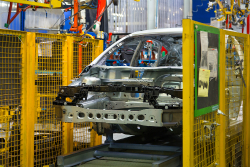Next-generation car manufacturing has already arrived
As renewable energy, climate change and carbon emissions become urgent priorities for the 21st century, industry is looking at brave new ways to address these challenges. One very promising and recently adopted approach to radically decrease pollution and emissions from transport vehicles is to make cars and even planes out of much lighter alloys. This would significantly reduce the amount of fuel needed and reduce manufacturing costs considerably, making these vehicles greener than ever. One particular EU-funded initiative that has in fact developed newly patented materials to support this aim was the project LOCOLITE (An industry system enabling the use of a patented materials processing technology for low cost forming of lightweight structures for transportation industries). Led by a team from the UK's Imperial College London, the project developed low-cost complex-shaped car-panel parts manufacturing technology for high-strength aluminium alloys, using a patented technology called Solution-Heat treatment, cold-die Forming & Quenching (HFQ). 'Compared with the current aluminium body structures for passenger cars that are produced conventionally, manufacturing costs could drop by 30-40 %', says Professor Jianguo Lin, one of the project partners from Imperial College London. 'In addition, the cost of design for a new car model could be reduced by EUR 25-35 million as many small components can be combined into one.' The numbers are impressive and speak for themselves: recent studies have shown component weight reduction of up to 55 %, depending on the grades of aluminium alloys selected. This in turn results in fuel savings between 20 and 25 % and carbon dioxide (CO2) emission reductions of up to 35 %, depending on models and makes. Electric cars also stand to benefit, boasting a higher travel range of up to 35 %, which makes them more commercially viable than ever. Driven by immediate interest from car manufacturers, the technology was adopted by British metal forming specialist, Impression Technologies Ltd, a spin-off company from the patented technology which established the world's first HFQ production line, built by AP&T (Sweden). 'Commercialisation has begun with niche carmakers in Britain – such as Aston Martin and Lotus Cars – to demonstrate the technology's benefits on the ground', notes Prof. Lin. The next step in the commercialisation process is to manufacture the novel low-cost, low-emission parts for premium cars such as Audi, BMW, Jaguar and Mercedes. 'We're now working to ensure that the technology for these makes will be employed in the next 2-3 years', says Prof. Lin. He adds that further commercialisation is expected to reach popular cars – i.e. class C and D vehicles – in another 5-7 years. Apart from the car industry, there has been interest from manufacturers of trucks, busses, trains and aircraft. With respect to vans, buses and trolley busses, fuel savings are expected to reach up to 20 %, while the reduction in CO2 emissions should reach 30 %, paving the way for much more environmentally friendly public transport and logistics. Huge material savings are expected for the aviation sector as well. 'We have successfully formed specific aircraft components which could reduce the manufacturing costs by at least five times compared to current technologies in which 95-97 % of materials are machined away.' The electronics sector also recently expressed strong interest in HFQ aluminium, especially for electric and electronic device casing such as for mobile phones. 'We expect to see applications in these sectors within the next two years', says Prof. Lin. Beyond reduced pollution from vehicles and decreased manufacturing costs, there are also savings that emerge from recycling. 'Aluminium can be recycled easily and it only takes about 5 % of energy to recycle it compared to getting the original aluminium', notes Prof. Lin. 'If recycled aluminium is used, the material costs could be reduced significantly.' Thanks to HFQ technology, transport manufacturing is on the cusp of a green paradigm shift, with other industries slated to follow soon.
Keywords
Car manufacturing, aluminium alloys, hot forming, Solution-Heat treatment, cold-die Forming & Quenching, HFQ







